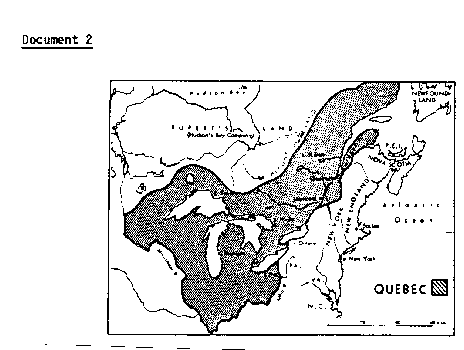
MODULE 3: " THE CONQUEST AND THE START OF BRITISH RULE"
UNIT 2: THE PROVINCE OF QUEBEC AND THE AMERICAN REVOLUTION
TOPIC A: THE QUEBEC ACT
TOPIC B: THE SHIFTING OF THE FUR TRADE
TOPIC C: THE ARRIVAL OF THE LOYALISTS
1. Unrest in the Thirteen American Colonies approached crisis proportions, the British government amended the constitution of the Province of Quebec in 1774.
Which of the following combinations corresponds to the major provisions of the Quebec Act?
A)
1. The territory was extended to include the Ohio Valley and Louisiana.
2. The 'Canadiens' could be part of the Sovereign Council.
3. French law, both civil and criminal, was to be applied.
B)
1. The territory was extended to include Labrador and the Ohio Valley.
2. The 'Canadiens' could be part of the governor's advisory council.
3. French civil law and English criminal law were to be applied.
C)
1. The territory was divided into Upper and Lower Canada.
2. The Canadiens could belong to the Assembly and the two Councils.
3. French Civil law and English Criminal law were to be applied.
D)
1. The territory was reduced to the region of the ST. LAWERENCE VALLEY.
2. The Canadiens could not be members of the Govenor's Adisory Council.
3. English law, both criminal and civil was to be applied.
2. THE QUEBEC ACT OF 1774:
And, for the more perfect Security and Ease of the Minds of the Inhabitants of the said Province, it is hereby
declared, That his Majesty's Subjects, professing the Religion of the Church of Rome of and in the said Province of Quebec, may have, hold, and enjoy, the free Exercise of the Religion of the Church of Rome, subject to the King's Supremacy ... and that the Clergy of the said Church may hold, receive, and enjoy, their accustomed Dues and only as shall profess the said Religion.The above excerpt from the Quebec Act of 1774 demonstrated a generous attitude on the part of the British government towards French Canadians. The British government passed this Act because of:
A) the necessity of a new relationship between English and French traders
B) the need to discourage American immigration to Quebec
C) growing unrest in the American colonies
D) the need to impose greater taxes on French Canadians
3. To which period in Canadian history do the contents of the following document refer?'The act reinstated French civil laws, retained the seigneurial system of tenure, freed Catholics from having to take the Test Oath, and officially recognized the tithe. It returned the area around the Great Lakes to the Province of Quebec and annexed to it "all the lands, islands, and regions which, since the tenth of February, one thousand seven hundred and sixty-three, have been annexed to the government of Newfoundland." It did not establish an assembly, but instead a new council composed of 17 to 23 members. Twelve British members and eight French Canadians were named to it.The Quebec Act thus offered to the seigneurs, the lawyers, and the clergy a guarantee to their property which, in the long run, encouragedthe survival of French Canadians as a distinct society
A) During the period of Royal Government
B) At the time of the Conquest
C) During the period of the American Revolution
D) After the Act of Union

4. In the face of increasing unrest in the Thirteen Colonies, Governor Guy Carleton persuaded London officials to grant the people of Quebec certain concessions out of fear that the 'Canadiens' might join the New England revolutionaries.With the help of the two documents below, identify the constitution that England granted the French Canadians on Carleton's request.
1. Catholics were to have full freedom of worship and the right to collect the tithe was restored. The Test Oath was abolished and the seigneurial system was retained. From that point on French civil laws were to be in effect.
2. (map)
A) the Constitutional Act
B) the Quebec Act
C) the Royal Proclamation
D) the Act of Union
5. FROM THE INVITATION SENT BY THE FIRST CONTINENTAL CONGRESS TO THE
FRENCH IN QUEBEC, OCTOBER 24, 1774:We only invite you to consult your own glory and welfare ...to unite with us in one social compact, formed on the generous principles of equal liberty ... In order to complete this highly desirable union ... we suggest that you choose Delegates to represent your province in the Continental Congress to be held in Philadelphia on the tenth day of May, 1775.
Which three groups, who had benefitted from the Quebec Act of 1774, encouraged the Quebec population to reject the above-mentioned appeal and remain loyal to Britain?
1. habitants
2. seigneurs
3. church leaders
4. Montreal merchants
5. Amerindians
A) 1, 2, and 4
B) 1, 3, and 5
C) 2, 3, and 4
D) 3, 4, and 5
6. American colonists rebelled against England in 1775-76 because of a series of British laws that affected them. One of these was the Quebec Act of 1774.
The Quebec Act greatly angered the American colonists because it:
A) prevented them from settling in Quebec
B) forced French Canadians to settle in the Thirteen Colonies
C) established democratic institutions in Quebec
D) annexed the Ohio Valley to Quebec
7. Fearing that the spirit of the American Revolution would spread to Canada, the British agreed to grant concessions to the French Canadians and gave them a new constitution whose main provisions are described in the text below."The act reinstated French civil laws, retained the seigneurial system of land tenure, freed the French- Canadian Catholics from having to take the Test Oath, and officially recognized the tithe. It returned the area around the Great Lakes to the Province of Quebec and annexed to it 'all the lands, islands, and regions which, since the tenth of February, seventeen hundred and sixty-three, had belonged to the government of Newfoundland.'
It did not establish an assembly, but instead created a new council of 17 to 23 members. Twelve British members and eight 'Canadiens' were named to it.(The act) thus offered the seigneurs, the French- Canadian lawyers and notaries and the clergy a guarantee of their property, which, in the long run, encouraged the survival of French Canadians as a distinct society."To which constitution does this refer?
A) the Royal Proclamation
B) the Quebec Act
C) the Act of Union
D) the British North America Act
8. With the Quebec Act of 1774, the British government granted certain concessions to the 'Canadiens' in order to ensure their loyalty.What was the reason for the adoption of the Quebec Act?
A) The desire to control the timber trade.
B) The shifting of the fur trade to the West
C) The increasing English population in the Province of Quebec
D) The upheaval in the Thirteen Colonies
9. In view of the growing discontent in the Thirteen (American)Colonies, Governor Carleton convinced London to grant certain concessions to the population of the Province of Quebec through the QUEBEC ACT.
What did London hope to achieve with these concessions?
A) To secure the 'Canadiens'' loyalty to England
B) To establish a democratic form of government
C) To calm the anger of the Americans
D) To stop the emigration of the 'Canadiens' to the United States
10. To which historical period does the following document refer? "The act reinstated French civil laws, retained the seigneurial system of land tenure, freed the French-Canadian Catholics from having to take the Test Oath, and officially recognized the tithe.It returned the area around the Great Lakes to the Province of Quebec and annexed to it 'all the lands, islands, and regions which, since the tenth of February, seventeen hundred and sixty-three, had belonged to the government of Newfoundland'. It did not establish an assembly, but instead created a new council of 17 to 23 members.Twelve British members and eight 'Canadiens' were named to it.The Quebec Act thus offered the seigneurs, the French-Canadian lawyers and notaries, and the clergy a guarantee of their property,which in the long run encouraged the survival of French Canadians as a distinct society."
A) The period of Royal Government
B) At the time of the Conquest
C) The period of the American Revolution
D) After the Act of Union
11. During the French Regime, furs remained the principal export of New France.The Conquest did not change the economic bases of the colony. However, once the needs of the British homeland changed, timber replaced furs as the principal product exported from the colony.Which letter on the time line below identifies the period when timber replaced furs as the principal product exported from the colony?
A) 1750 - 1800
B) 1800 - 1850
C) 1850 - 1900
D) 1900 - 1950
12. As the independence of the United States became a reality,the Northwest Company, a new fur-trading company with its headquarters in Montreal,came into being.Following the creation of this new company, the fur trade:
A) extended to the Gulf of Mexico
B) expanded south of the Great Lakes
C) moved towards Hudson Bay
D) shifted towards the West
13. The United States of America became independent from England in 1783.This historical event changed the history of Quebec and Canada.Which of the following documents illustrates one of the consequences of American independence?
A) (diagram)
B) (map)
C) (graph)
D) (map)
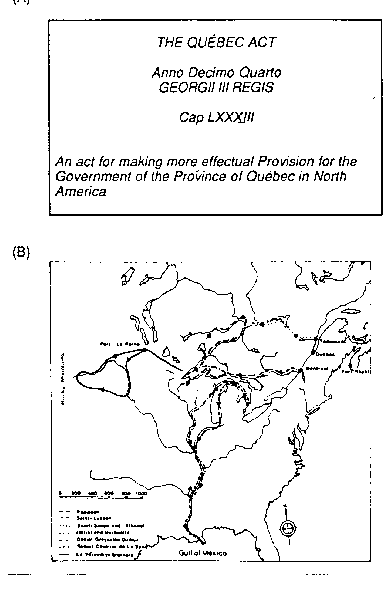
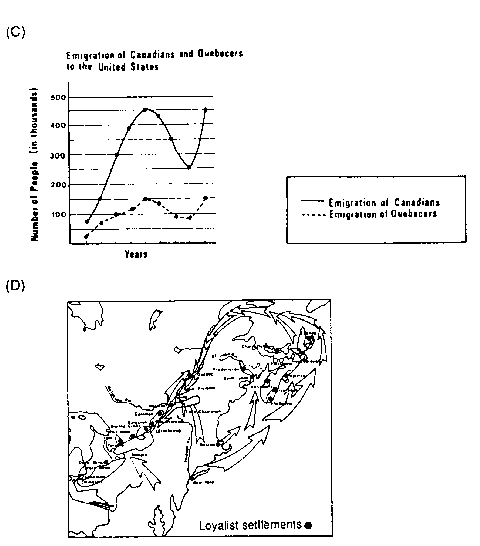
14. Following the American Revolution, some of the Loyalists who were faithful to the British Crown came to settle down in the Province of Quebec.Two of the following documents illustrate consequences of this influx of the Loyalists into Canada. Which are they?
A) 1 and 2
B) 1 and 3
C) 2 and 4
D) 4 and 5

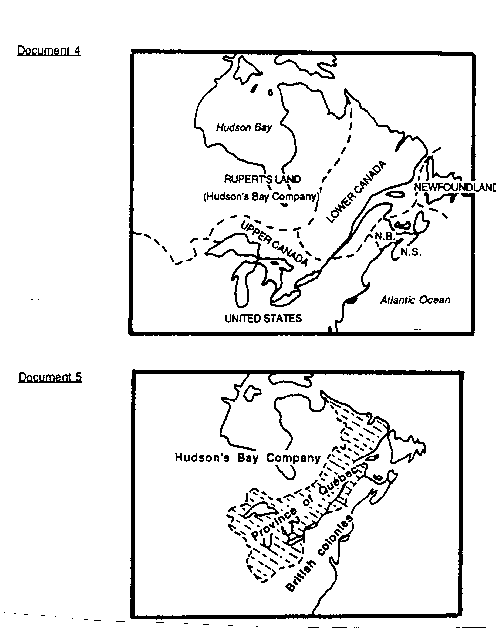
15. When the American Revolution was over, the Loyalists left the United States and some took refuge to the north.What were the consequences of the arrival of the Loyalists in the Province of Quebec?
1. French Canadians retained control over the fur trade.
2. The constitution of the Province of Quebec was modified.
3. French Canadians were moved off the seigneuries.
4. The percentage of French Canadians in the Province of Quebec decreased.
5. The territory of the Province of Quebec was increased.
A) 1 and 2
B) 2 and 3
C) 2 and 4
D) 4 and 5
16. Which of the following documents illustrates a result of the American War of Independence?
A) (map)
B) (graph)
C) "... Along this stretch of four thousand miles lived a French
population that was insignificant in size: 65 000 inhabitants; while
along an Atlantic stretch half this size, the English colonies had
settled a population fourteen times larger."
D) (illustration) 
17. In 1783, England recognized American Independence. The thirteen Colonies became the United States of America.What was the immediate consequence of American independence on settlement in the Province of Quebec?
The arrival of Loyalists in British North America resulted in:
1. a new system of land management
2. abolition ofthe seigneurial system
3. the creation of new provinces
4. the introduction of new political ideas
5. the union of several British colonies
A) 1, 2, and 5
B) 1, 3, and 4
C) 2, 3, and 4
D) 3, 4, and 5
18. The United States of America became independent from Englandin 1783.
This historical event changed the history of Quebec and Canada.
Which of the following documents illustrates one of the CONSEQUENCES of American independence?
A) (The Quebec Act)
B) (graph)
C) (map)
D) (map) 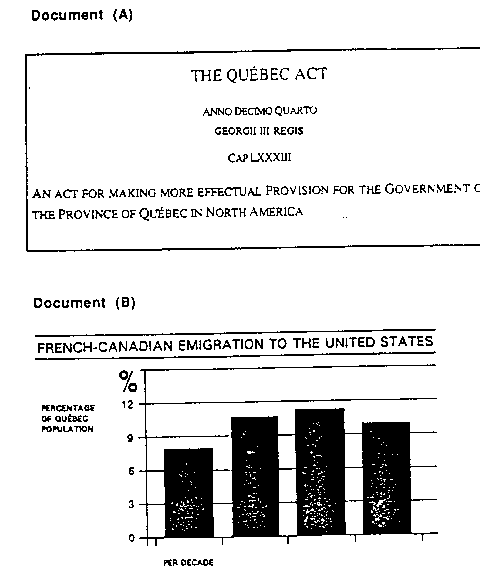
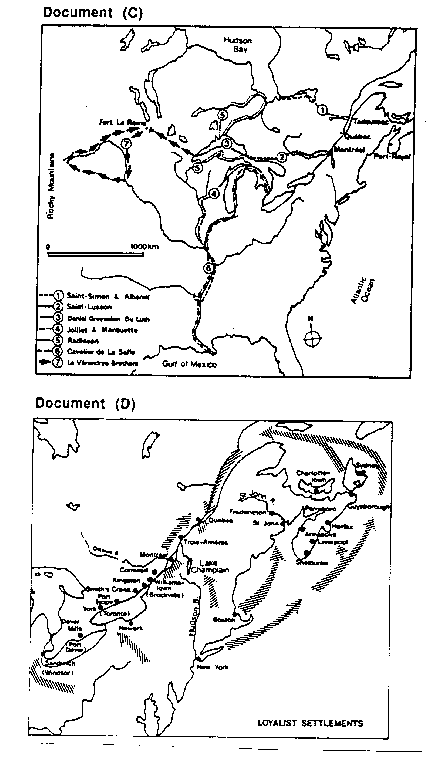
THIS TEST IS ON: MODULE 3:
" THE CONQUEST AND THE START OF BRITISH RULE"
UNIT 2: THE PROVINCE OF QUEBEC AND THE AMERICAN REVOLUTION
TOPIC A: THE QUEBEC ACT
TOPIC B: THE SHIFTING OF THE FUR TRADE
TOPIC C: THE ARRIVAL OF THE LOYALISTS
1. Ans: B Diff.: 3 Page: 88-6-8 Refer To:
Topic: THE QUEBEC ACT 2A
File: M3U2 -2 .........1
2. Ans: C Diff.: 3 Page: 89-1-15 Refer To:
Topic: THE QUEBEC ACT 2A
File: M3U2 -2 .........2
3. Ans: B Diff.: 3 Page: 89-1-9 Refer To:
Topic: THE QUEBEC ACT 2A
File: M3U2 -2 .........3
4. Ans: B Diff.: 3 Page: 89-6-8 Refer To: 0303
Topic: THE QUEBEC ACT 2A
File: M3U2 -2 .........4
5. Ans: C Diff.: 3 Page: 89-8-15 Refer To:
Topic: THE QUEBEC ACT 2A
File: M3U2 -2 .........5
6. Ans: D Diff.: 3 Page: 90-1-15 Refer To:
Topic: THE QUEBEC ACT 2A
File: M3U2 -2 .........6
7. Ans: B Diff.: 3 Page: 90-8-7 Refer To:
Topic: THE QUEBEC ACT 2A
File: M3U2 -2 .........7
8. Ans: D Diff.: 3 Page: 91-1-10 Refer To:
Topic: THE QUEBEC ACT 2A
File: M3U2 -2 .........8
9. Ans: A Diff.: 3 Page: 91-6-9 Refer To:
Topic: THE QUEBEC ACT 2A
File: M3U2 -2 .........9
10. Ans: C Diff.: 3 Page: 91-8-7 Refer To:
Topic: THE QUEBEC ACT 2A
File: M3U2 -2 ........10
11. Ans: B Diff.: 3 Page: 88-1-8 Refer To:
Topic: SHIFTING OF FUR TRADE 2B
File: M3U2 -2 ........11
12. Ans: D Diff.: 3 Page: 88-6-7 Refer To:
Topic: SHIFTING OF FUR TRADE 2B
File: M3U2 -2 ........12
13. Ans: D Diff.: 3 Page: 90-8-8 Refer To: 0304
Topic: THE LOYALISTS 2C
File: M3U2 -2 ........13
14. Ans: A Diff.: 3 Page: 88-1-7 Refer To: 0305
Topic: THE LOYALISTS 2C
File: M3U2 -2 ........14
15. Ans: C Diff.: 3 Page: 89-1-10 Refer To:
Topic: THE LOYALISTS 2C
File: M3U2 -2 ........15
16. Ans: B Diff.: 3 Page: 90-1-16 Refer To: 0306
Topic: THE LOYALISTS 2C
File: M3U2 -2 ........16
17. Ans: B Diff.: 3 Page: 90-6-23 Refer To:
Topic: THE LOYALISTS 2C
File: M3U2 -2 ........17
18. Ans: D Diff.: 3 Page: 91-8-8 Refer To: 0307
Topic: THE LOYALISTS 2C
File: M3U2 -2 ........18